- 0 Shopping Cart


Kerala flood case study
Kerala flood case study.
Kerala is a state on the southwestern Malabar Coast of India. The state has the 13th largest population in India. Kerala, which lies in the tropical region, is mainly subject to the humid tropical wet climate experienced by most of Earth’s rainforests.
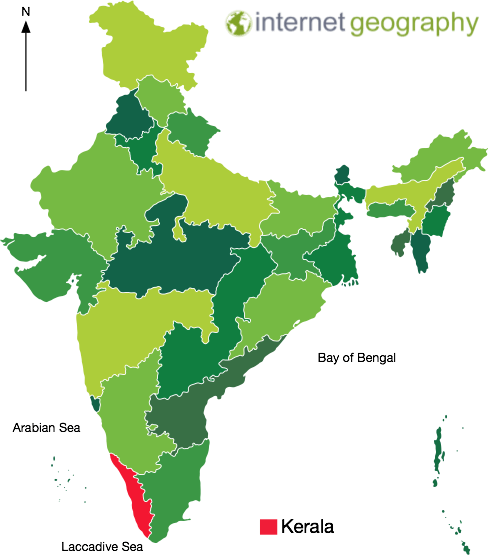
A map to show the location of Kerala
Eastern Kerala consists of land infringed upon by the Western Ghats (western mountain range); the region includes high mountains, gorges, and deep-cut valleys. The wildest lands are covered with dense forests, while other areas lie under tea and coffee plantations or other forms of cultivation.
The Indian state of Kerala receives some of India’s highest rainfall during the monsoon season. However, in 2018 the state experienced its highest level of monsoon rainfall in decades. According to the India Meteorological Department (IMD), there was 2346.3 mm of precipitation, instead of the average 1649.55 mm.
Kerala received over two and a half times more rainfall than August’s average. Between August 1 and 19, the state received 758.6 mm of precipitation, compared to the average of 287.6 mm, or 164% more. This was 42% more than during the entire monsoon season.
The unprecedented rainfall was caused by a spell of low pressure over the region. As a result, there was a perfect confluence of the south-west monsoon wind system and the two low-pressure systems formed over the Bay of Bengal and Odisha. The low-pressure regions pull in the moist south-west monsoon winds, increasing their speed, as they then hit the Western Ghats, travel skywards, and form rain-bearing clouds.
Further downpours on already saturated land led to more surface run-off causing landslides and widespread flooding.
Kerala has 41 rivers flowing into the Arabian Sea, and 80 of its dams were opened after being overwhelmed. As a result, water treatment plants were submerged, and motors were damaged.
In some areas, floodwater was between 3-4.5m deep. Floods in the southern Indian state of Kerala have killed more than 410 people since June 2018 in what local officials said was the worst flooding in 100 years. Many of those who died had been crushed under debris caused by landslides. More than 1 million people were left homeless in the 3,200 emergency relief camps set up in the area.
Parts of Kerala’s commercial capital, Cochin, were underwater, snarling up roads and leaving railways across the state impassable. In addition, the state’s airport, which domestic and overseas tourists use, was closed, causing significant disruption.
Local plantations were inundated by water, endangering the local rubber, tea, coffee and spice industries.
Schools in all 14 districts of Kerala were closed, and some districts have banned tourists because of safety concerns.
Maintaining sanitation and preventing disease in relief camps housing more than 800,000 people was a significant challenge. Authorities also had to restore regular clean drinking water and electricity supplies to the state’s 33 million residents.
Officials have estimated more than 83,000km of roads will need to be repaired and that the total recovery cost will be between £2.2bn and $2.7bn.
Indians from different parts of the country used social media to help people stranded in the flood-hit southern state of Kerala. Hundreds took to social media platforms to coordinate search, rescue and food distribution efforts and reach out to people who needed help. Social media was also used to support fundraising for those affected by the flooding. Several Bollywood stars supported this.
Some Indians have opened up their homes for people from Kerala who were stranded in other cities because of the floods.
Thousands of troops were deployed to rescue those caught up in the flooding. Army, navy and air force personnel were deployed to help those stranded in remote and hilly areas. Dozens of helicopters dropped tonnes of food, medicine and water over areas cut off by damaged roads and bridges. Helicopters were also involved in airlifting people marooned by the flooding to safety.
More than 300 boats were involved in rescue attempts. The state government said each boat would get 3,000 rupees (£34) for each day of their work and that authorities would pay for any damage to the vessels.
As the monsoon rains began to ease, efforts increased to get relief supplies to isolated areas along with clean up operations where water levels were falling.
Millions of dollars in donations have poured into Kerala from the rest of India and abroad in recent days. Other state governments have promised more than $50m, while ministers and company chiefs have publicly vowed to give a month’s salary.
Even supreme court judges have donated $360 each, while the British-based Sikh group Khalsa Aid International has set up its own relief camp in Kochi, Kerala’s main city, to provide meals for 3,000 people a day.
International Response
In the wake of the disaster, the UAE, Qatar and the Maldives came forward with offers of financial aid amounting to nearly £82m. The United Arab Emirates promised $100m (£77m) of this aid. This is because of the close relationship between Kerala and the UAE. There are a large number of migrants from Kerala working in the UAE. The amount was more than the $97m promised by India’s central government. However, as it has done since 2004, India declined to accept aid donations. The main reason for this is to protect its image as a newly industrialised country; it does not need to rely on other countries for financial help.
Google provided a donation platform to allow donors to make donations securely. Google partners with the Center for Disaster Philanthropy (CDP), an intermediary organisation that specialises in distributing your donations to local nonprofits that work in the affected region to ensure funds reach those who need them the most.
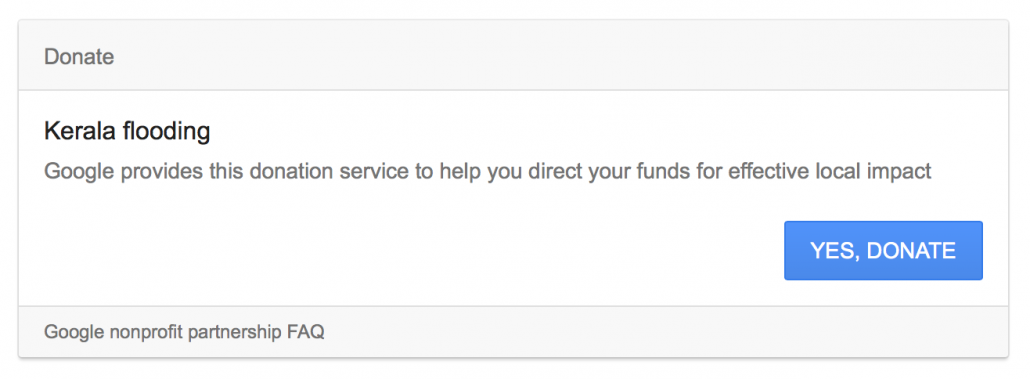
Google Kerala Donate
Tales of humanity and hope
Check your understanding.

Premium Resources
Please support internet geography.
If you've found the resources on this page useful please consider making a secure donation via PayPal to support the development of the site. The site is self-funded and your support is really appreciated.
Related Topics
Use the images below to explore related GeoTopics.
River flooding and management
Topic home, wainfleet floods case study, share this:.
- Click to share on Twitter (Opens in new window)
- Click to share on Facebook (Opens in new window)
- Click to share on Pinterest (Opens in new window)
- Click to email a link to a friend (Opens in new window)
- Click to share on WhatsApp (Opens in new window)
- Click to print (Opens in new window)
If you've found the resources on this site useful please consider making a secure donation via PayPal to support the development of the site. The site is self-funded and your support is really appreciated.
Search Internet Geography
Top posts and pages.
Latest Blog Entries
Pin It on Pinterest
- Click to share
- Print Friendly
Content Search
Study report: kerala floods of august 2018 (september, 2018).
- Govt. India
Attachments

1.0 Introduction
Kerala State has an average annual precipitation of about 3000 mm. The rainfall in the State is controlled by the South-west and North-east monsoons. About 90% of the rainfall occurs during six monsoon months. The high intensity storms prevailing during the monsoon months result in heavy discharges in all the rivers. The continuous and heavy precipitation that occurs in the steep and undulating terrain finds its way into the main rivers through innumerable streams and water courses.
Kerala experienced an abnormally high rainfall from 1 June 2018 to 19 August 2018. This resulted in severe flooding in 13 out of 14 districts in the State. As per IMD data, Kerala received 2346.6 mm of rainfall from 1 June 2018 to 19 August 2018 in contrast to an expected 1649.5 mm of rainfall. This rainfall was about 42% above the normal. Further, the rainfall over Kerala during June, July and 1st to 19th of August was 15%, 18% and 164% respectively, above normal. Month-wise rainfall for the period, as reported by IMD, are given in Table-1.
Due to heavy rainfall, the first onset of flooding occurred towards the end of July. A severe spell of rainfall was experienced at several places on the 8th and 9th of August 2018. The 1- day rainfall of 398 mm, 305 mm, 255 mm, 254 mm, 211 mm and 214 mm were recorded at Nilambur in Malappuram district, Mananthavadi in Wayanad district, Peermade, Munnar KSEB and Myladumparain in Idukki district and Pallakad in Pallakad district respectively on 9 August 2018. This led to further flooding at several places in Mananthavadi and Vythiri in Wayanad district during 8-10, August 2018. Water was released from several dams due to heavy rainfall in their catchments. The water levels in several reservoirs were almost near their Full Reservoir Level (FRL) due to continuous rainfall from 1st of June. Another severe spell of rainfall started from the 14th of August and continued till the 19th of August, resulting in disastrous flooding in 13 out of 14 districts. The water level records at CWC G&D sites for some of the rivers in Kerala are given at Annex-I. As per the rainfall records of IMD, it has been found that the rainfall depths recorded during the 15-17, August 2018 were comparable to the severe storm that occurred in the year 1924.
1.1 Earlier floods in Kerala
The 1924 witnessed unprecedented and very heavy floods in almost all rivers of Kerala. Heavy losses to life, property and crops etc. had been reported. The rainstorm of 16-18, July 1924 was caused by the South-west monsoon that extended to the south of peninsula on 15th July and caused rainfall in Malabar. Under its influence, heavy rainfall occurred in almost entire Kerala. The area under the storm recorded 1-day maximum rainfall on 17th of July, 2- day maximum rainfall for 16-17, July 1924 and 3-day maximum rainfall for 16-18, July 1924. The centre of the 1-day and 2-day rainstorm was located at Devikulam in Kerala which recorded 484 mm and 751 mm of rainfall respectively. The centre of 3-day rainstorm was located at Munnar in Kerala which recorded a rainfall of 897 mm in 3 days.
The fury of 1924 flood levels in most of the rivers was still fresh in the memory of people of Kerala, the year 1961 also witnessed heavy floods and rise in the water levels of reservoirs. Usually in the State, heavy precipitation is concentrated over a period of 7 to 10 days during the monsoon when the rivers rise above their established banks and inundate the low lying areas. But in 1961, floods were unusually heavy not only in duration, but also in the intensity of precipitation. During the year 1961, the monsoon started getting violent towards the last week of June and in the early days of August, the precipitation was concentrated on most parts of the southern region of Kerala. By the first week of July, the intensity gradually spread over the other parts of the State and the entire State was reeling under severe flood by the second week of July. The worst affected area was Periyar sub-basin and it also impacted other sub-basins. Many of the important infrastructures like highways etc were submerged. After a brief interval, by the middle of July, the monsoon became more violent, affecting the northern parts of the State. The average rainfall was 56% above normal. The maximum daily intensities recorded at four districts in 1961 are given in Table-2.
Related Content
Leaving no one behind: lessons from the kerala disasters, india: kerala floods dref n° mdrin020 emergency plan of action final report, kerala flood victims receive wash, shelter & livelihood support under athijeevana launch at bodhana, athijeevan: fighting back to attain stability after kerala flood.
Kerala Floods 2018: Impacts and Lessons Drawn
- Living reference work entry
- First Online: 27 October 2022
- Cite this living reference work entry

- Ajinder Walia 2 ,
- Pallvi Sharma 2 &
- Naima Nusrat 3
88 Accesses
1 Citations
Kerala, the southwest coastal state of India which ranks high on the Human Development Index, became vulnerable to severe flooding during the southwest monsoons of 2018. The state faced the worst floods in the century due to above-normal rainfall from June to August 2018. The above-normal rainfall was supplemented by a lack of integration of sustainable development practices and disaster risk management strategies. The floods affected all the districts of the state and led to the loss of over 400 precious lives along with extensive damage to infrastructure and property. It also triggered about 341 landslides in the area. The community including fishermen and women-centric organizations like Kudumbashree participated actively in responding to the disaster. Technology including WhatsApp, GIS, and crowdsourcing was used actively by the community during the search, rescue, and relief phase. The floods highlighted many constraints like lack of proper management and monitoring of critical natural resources such as water and land which left the state unprepared for major disasters caused by natural hazards. The disaster also highlighted crucial lessons to be adopted by other coastal states of the country which are expected to face increased flooding in the coming times due to climatic changes.
This is a preview of subscription content, log in via an institution to check access.
Access this chapter
Institutional subscriptions
Ajay, A. (2019). Role of technology in responding to disasters: Insights from the Great Deluge in Kerala. Current Science, 116 (6), 913.
Article Google Scholar
Anand, G. (2018, August 19). When help dropped from the skies: How IAF rescued 1000s from flood-ravaged Kerala. The Hindu . Retrieved December 1, 2021, from https://www.thehindu.com/news/national/kerala/when-help-dropped-from-the-skies-how-iaf-rescued-1000s-from-flood-ravaged-kerala/article24732423.ece
Anandan, S. (2018, August 28). Kerala floods: Kudumbashree Women Play Big Role in clean-up . The Hindu. Retrieved October 22, 2021, from https://www.thehindu.com/news/national/kerala/kudumbasree-collects-5-cr-for-flood-relief/article24801984.eceaspx
Azzali, S., Kamble, Z., Thirumaran, K., Wong, C., & Wood, J. (2021). Mitigating impact from natural disasters, building resilience in tourism: The case of Kerala. Economic Effects of Natural Disasters, 120 . https://doi.org/10.1016/b978-0-12-817465-4.00008-x
Chief Executive Officer. (2019). Kerala rebuild initiative . Rebuild Kerala Initiative-RKI. Retrieved August 29, 2021, from https://rebuild.kerala.gov.in/en/
Google Scholar
Committee, G. (2011). (rep.). Report of the Western Ghats ecology expert panel part I . Kerala State Biodiversity Board.
Duncombe, J. (2018). Making sense of landslide danger after Kerala’s floods. Economic and Political Weekly, 53 (34). https://doi.org/10.1029/2018eo108061 . e9-127m.pdf.
ENVIS Hub: Kerala state of environment and related issues . Physiography. (n.d.). Retrieved February 20, 2021., from http://www.kerenvis.nic.in/Database/ENVIRONMENT_824
Government of Kerala. (2018). Kerala post disaster needs assessment: Floods and landslides - August 2018 (October 2018) - India. Relief Web . Kerala: World Bank. Retrieved October 12, 2021, from https://reliefweb.int/report/India/kerala-post-disast er-needs-assessment-floods-and-landslides-august-2018-October-2018
Hydrological Studies Organization Hydrology (S) Directorate. (2018). Kerala floods of August 2018 . Central Water Commission. Retrieved December 23, 2021, from https://reliefweb.int/sites/reliefweb.int/files/resources/Rev-0.pdf
ICAR. (2018, September). Report on impact of rain induced natural calamity on spice crops in Kerala. ICAR-Indian Institute of Spices Research. Retrieved March 38, 2021, from http://spices.res.in/pages/report-impact-rain-induced-natural-calamity-spice-crops-kerala
IMD. (2018). Kerala floods 2018. Indian Meteorological Department, Ministry of Earth Sciences, Government of India. Retrieved September 16, 2021, from https://mausam.imd.gov.in/search_RV/index.php
IMF. (2021). Implied PPP conversion rate . Imf.org. IMF. Retrieved January 13, 2021, from https://www.imf.org/external/datamapper/pppex@weo/oemdc/advec/weoworld/da/ind?year=2018
Indian Navy. (2018). SNC initiates operation ‘Madad’ at Wayanad, Kerala. SNC Initiates Operation ‘Madad’ at Wayanad, Kerala | Indian Navy. Retrieved February 9, 2022, from https://www.indiannavy.nic.in/content/snc-initiates-operation-madad-wayanad-kerala
IPCC. (2021). Chapter 4: Sea level rise and implications for low-lying islands. IPCC. Retrieved September 16, 2022, from https://www.ipcc.ch/srocc/chapter/chapter-4-sea-level-rise-and-implications-for-low-lying-islands-coasts-and-communities/
Kerala State Disaster Management Authority. (2016). Kerala State Disaster Management Plan . KSDMA. Kerala: Department of Revenue and Disaster Management.
Kerala State Government. (2018). Report on the exceptionally heavy rainfall over Kerala during 1st – 19th Aug. 2018. Meteorological Centre, Thiruvananthapuram. Retrieved April 11, 2021, from https://sdma.kerala.gov.in/wp-content/uploads/2020/08/IMD-Monsoon-Extreme-Rainfall-2018.pdf
Kumar, R. (2018, October 12). Kerala floods: From the eyes of Wetlands . Wetlands International.
Ministry of Health and Family Welfare. (2017). State fact sheet Kerala. Rchiips.org . Mumbai: International Institute for Population Sciences. Retrieved December 29, 2021 from http://rchiips.org/nfhs/pdf/NFHS4/KL_FactSheet.pdf
Mohanti, M., & Sheikh, S. (2019, March 17). Kerala floods: What led to deluge that reminded people of the great flood of 1999 . News18. Cable News Network LP.
Narayanan, K. (2018, August 19). What caused the Kerala floods? Could we have done anything to prevent it? Technology News, Firstpost. Retrieved August 19, 2018, from https://www.firstpost.com/tech/news-analysis/what-caused-the-kerala-floods4993041.html#:~:text=Some%20reasons%20for%20its%20vulnerability
NDRF. (2018). Kerala floods - 2018: NDRF - National Disaster Response Force. National Disaster Response Force, Ministry of Home Affairs, Government of India. Retrieved September 16, 2022, from https://ndrf.gov.in/operations/kerala-floods-2018
Pr Cell. (2018, August 18). Kerala floods: NDRF scaled up its rescue & evacuation operation, 194 rescued & over 10,400 evacuated till now | NDRF - National Disaster Response Force. NDRF HQ, New Delhi. Retrieved September 28, 2020, from http://www.ndrf.gov.in/pressrelease/kerala-floods-ndrf-scaled-its-rescue-evacuation-operation-194-rescued-over-10400
RBI. (2020). Handbook of statistics on Indian states . Reserve Bank of India.
SBI. (2019). Human development index across Indian states: Is the glass still half empty? Ecowrap, 94 (FY19).: https://www.sbi.co.in/documents/13958/14472/Ecowrap_20190308.pdf
SDMA. (2021). Kerala Floods 2018. SDMA Kerala. Retrieved September 15, 2022, from https://sdma.kerala.gov.in/wp-content/uploads/2019/03/PDNA-report-FINAL-FEB-2019_compressed.pdf
Special Correspondent. (2018, August 20). Centre says Kerala floods ‘Calamity of severe nature’. The Hindu . https://www.thehindu.com/news/national/kerala-floods-declared-calamity-of-severenature/article24738072.ece
State Government of Kerala. (2019). Rebuild Kerala development program: A resilient recovery policy framework and action plan for shaping Kerala’s resilient, risk-informed development and recovery from 2018 floods . Rebuild.kerala.gov.in. Kerala: Government of Kerala. https://rebuild.kerala.gov.in/reports/RKDPMaster%2021May2019.pdf
State Level Bankers’ Committee Kerala. (2019). Slbckerala.com . Retrieved June 19, 2021, from http://slbckerala.com/images/Meetings/23826648-aa8a-4e5f-ac2c-059b418e71
State Relief Commissioner. (2018). Additional memorandum . Sdma.kerala.gov.in . Kerala: Disaster Management (Additional Chief Secretary) Government of Kerala. https://sdma.kerala.gov.in/wp-content/uploads/2019/08/Memorandum2-Floods-2018.pdf
United Nations Development Programme. (2018, December 12). Kerala post disaster needs assessment floods and landslides - August 2018 . Retrieved January 23, 2021 from https://www.undp.org/content/undp/en/home/librarypage/crisis-prevention-andrecovery/post-disaster-needs-assessment-kerala.html on June 2018.
Walia, A., & Nusrat, N. (2020). Kerala floods 2018 . National Institute of Disaster Management.
Welankar, P. (2018, August 19). Illegal Forest land acquisition major reason for floods in Kerala, says ecologist Madhav Gadgil, calls it man-made disaster. Hindustan Times . Hindustan Times Pvt. Ltd.
WRI INDIA (2018, September 03). Kerala Flooding: Natural Calamity or Manmade Disaster? Retrieved July 2021, from https://wri-india.org/blog/kerala-flooding-natural-calamity-ormanmadedisaster
Download references
Author information
Authors and affiliations.
National Institute of Disaster Management (NIDM), Ministry of Home Affairs, Government of India, New Delhi, India
Ajinder Walia & Pallvi Sharma
Red Orange Media and Communications, Dhaka, Bangladesh
Naima Nusrat
You can also search for this author in PubMed Google Scholar
Editor information
Editors and affiliations.
Centre for the Study of Law and Governance, Jawaharlal Nehru University, New Delhi, Delhi, India
Amita Singh
Section Editor information
Indian Administrative Service (Retired), Delhi, India
Nivedita Haran

Rights and permissions
Reprints and permissions
Copyright information
© 2022 Springer Nature Singapore Pte Ltd.
About this entry
Cite this entry.
Walia, A., Sharma, P., Nusrat, N. (2022). Kerala Floods 2018: Impacts and Lessons Drawn. In: Singh, A. (eds) International Handbook of Disaster Research. Springer, Singapore. https://doi.org/10.1007/978-981-16-8800-3_188-1
Download citation
DOI : https://doi.org/10.1007/978-981-16-8800-3_188-1
Received : 18 May 2022
Accepted : 30 July 2022
Published : 27 October 2022
Publisher Name : Springer, Singapore
Print ISBN : 978-981-16-8800-3
Online ISBN : 978-981-16-8800-3
eBook Packages : Springer Reference Business and Management Reference Module Humanities and Social Sciences Reference Module Business, Economics and Social Sciences
- Publish with us
Policies and ethics
- Find a journal
- Track your research

Preprint
- Preprint hess-2018-480
The Kerala flood of 2018: combined impact of extreme rainfall and reservoir storage
Abstract. Extreme precipitation events and flooding that cause losses to human lives and infrastructure have increased under the warming climate. In August 2018, the state of Kerala (India) witnessed large-scale flooding, which affected millions of people and caused 400 or more deaths. Here, we examine the return period of extreme rainfall and the potential role of reservoirs in the recent flooding in Kerala. We show that Kerala experienced 53 % above normal rainfall during the monsoon season (till August 21st) of 2018. Moreover, 1, 2, and 3-day extreme rainfall in Kerala during August 2018 had return periods of 75, 200, and 100 years. Six out of seven major reservoirs were at more than 90 % of their full capacity on August 8, 2018, before extreme rainfall in Kerala. Extreme rainfall at 1–15 days durations in August 2018 in the catchments upstream of the three major reservoirs (Idukki, Kakki, and Periyar) had the return period of more than 500 years. Extreme rainfall and almost full reservoirs resulted in a significant release of water in a short-span of time. Therefore, above normal seasonal rainfall (before August 8, 2018), high reservoir storage, and unprecedented extreme rainfall in the catchments where reservoirs are located worsened the flooding in Kerala. Reservoir operations need be improved using a skillful forecast of extreme rainfall at the longer lead time (4–7 days).
- Preprint (PDF, 1270 KB)
- Supplement (18683 KB)
- Preprint (1270 KB)
- Metadata XML

https://doi.org/10.5194/hess-2018-480-supplement
- HTML: 8,917
- Total: 12,593
- Supplement: 389
- EndNote: 96
Viewed (geographical distribution)

43 citations as recorded by crossref.
- Assessment of extreme rainfall events over Kerala using EVA and NCUM-G model forecasts V. Abhijith et al. 10.1007/s12040-023-02171-5
- Flood impact assessment using field investigations and post-flood survey A. Mathew et al. 10.1007/s12040-021-01657-4
- Landslide susceptibility investigation for Idukki district of Kerala using regression analysis and machine learning S. Jones et al. 10.1007/s12517-021-07156-6
- Persistent Scatterer Interferometry in the post-event monitoring of the Idukki Landslides J. Jennifer et al. 10.1080/10106049.2020.1778101
- Endemism-based butterfly conservation: insights from a study in Southern Western Ghats, India M. Anto et al. 10.1186/s41936-021-00221-2
- Spatiotemporal dependence of soil moisture and precipitation over India A. Manoj J et al. 10.1016/j.jhydrol.2022.127898
- Microplastic pollution of Calicut beach - Contributing factors and possible impacts A. Kumar & G. Varghese 10.1016/j.marpolbul.2021.112492
- Identifying Flood Prediction using Machine Learning Techniques M. Helen Joyice et al. 10.38124/ijisrt/IJISRT24MAR112
- Real-time flood forecasting using an integrated hydrologic and hydraulic model for the Vamsadhara and Nagavali basins, Eastern India G. Venkata Rao et al. 10.1007/s11069-023-06366-3
- Probabilistic Mapping of August 2018 Flood of Kerala, India, Using Space-Borne Synthetic Aperture Radar S. Sherpa et al. 10.1109/JSTARS.2020.2970337
- Increase in Population Exposure Due to Dry and Wet Extremes in India Under a Warming Climate R. Kumar & V. Mishra 10.1029/2020EF001731
- Vulnerability and resilience of the tourism sector in India: Effects of natural disasters and internal conflict M. Barbhuiya & D. Chatterjee 10.1016/j.tmp.2019.100616
- Increased flood risk in Indian sub-continent under the warming climate H. Ali et al. 10.1016/j.wace.2019.100212
- A diagnostic study of extreme precipitation over Kerala during August 2018 Y. Viswanadhapalli et al. 10.1002/asl.941
- Assessment of land surface temperature dynamics over the Bharathapuzha River Basin, India J. John et al. 10.1007/s11600-021-00593-7
- Impacts of Flood on Water Quality of Periyar River and Remediation Using Natural Fibers P. Ayyappan Vasantha et al. 10.1080/15440478.2022.2057382
- Modeling the concurrent impact of extreme rainfall and reservoir storage on Kerala floods 2018: a Copula approach A. Anandalekshmi et al. 10.1007/s40808-019-00635-6
- Investigation on the Failure Mechanism of Rainfall-Induced Long-Runout Landslide at Upputhode, Kerala State of India R. Andrewwinner & S. Chandrasekaran 10.3390/land10111212
- Association of Flood Risk Patterns with Waterborne Bacterial Diseases in Malaysia N. Shafii et al. 10.3390/w15112121
- Combined signatures of atmospheric drivers, soil moisture, and moisture source on floods in Narmada River basin, India J. Nanditha et al. 10.1007/s00382-022-06244-x
- Evaluating the long-term trends of the climatic variables over three humid tropical basins in Kerala, India A. Abraham & S. Kundapura 10.1007/s12517-022-10056-y
- Development of flood susceptibility map using a GIS-based AHP approach: a novel case study on Idukki district, India Z. Khan & B. Jhamnani 10.1080/14498596.2023.2236051
- SAR based flood risk analysis: A case study Kerala flood 2018 N. Pramanick et al. 10.1016/j.asr.2021.07.003
- Epizootics of epizootic ulcerative syndrome among estuarine fishes of Kerala, India, under post-flood conditions T. Sumithra et al. 10.3354/dao03465
- Assessment of Nonstationarity and Uncertainty in Precipitation Extremes of a River Basin Under Climate Change S. Ansa Thasneem et al. 10.1007/s10666-021-09752-y
- C-band polarimetric Doppler Weather Radar observations during an extreme precipitation event and associated dynamics over Peninsular India K. Subrahmanyam & K. Kumar 10.1007/s11069-022-05426-4
- Simulation of an extreme rainfall event over Mumbai using a regional climate model: a case study M. Pant et al. 10.1007/s00703-021-00845-7
- Country‐wide flood exposure analysis using Sentinel‐1 synthetic aperture radar data: Case study of 2019 Iran flood S. Sherpa & M. Shirzaei 10.1111/jfr3.12770
- Coordination and control – limits in standard representations of multi-reservoir operations in hydrological modeling C. Rougé et al. 10.5194/hess-25-1365-2021
- Sensitivity analysis applied to two extreme rainfall events over Kerala using TIGGE ensembles B. George & G. Kutty 10.1007/s00703-022-00863-z
- Evaluating the 2018 extreme flood hazard events in Kerala, India P. Lal et al. 10.1080/2150704X.2020.1730468
- Interaction of a Low-Pressure System, an Offshore Trough, and Mid-Tropospheric Dry Air Intrusion: The Kerala Flood of August 2018 V. Kumar et al. 10.3390/atmos11070740
- Impacts of a massive flood event on the physico-chemistry and water quality of river Pampa in Western Ghats of India A. Saha et al. 10.1080/03067319.2020.1843026
- Deciphering the extreme rainfall scenario over Indian landmass using satellite observations, reanalysis and model forecast: Case studies U. Saha et al. 10.1016/j.atmosres.2020.104943
- Role of Extreme Precipitation and Initial Hydrologic Conditions on Floods in Godavari River Basin, India S. Garg & V. Mishra 10.1029/2019WR025863
- Flood 2018 and the status of reservoir-induced seismicity in Kerala, India S. Ramasamy et al. 10.1007/s11069-019-03741-x
- Bias-Corrected Extended-Range Forecast Over India for Hydrological Applications During Monsoon 2020 P. Kumar et al. 10.1007/s00024-022-02998-x
- The anomalous weather parameters that lead to the extreme rainfall of Kerala in August 2018 S. Suneela et al. 10.1007/s00703-023-00974-1
- Impact of Time Step Size on Different Cumulus Parameterization Schemes in the Numerical Simulation of a Heavy Rainfall Event Over Tamil Nadu, India K. Singh et al. 10.1007/s00024-021-02896-8
- Constructing a complete landslide inventory dataset for the 2018 monsoon disaster in Kerala, India, for land use change analysis L. Hao et al. 10.5194/essd-12-2899-2020
- Assessment of the impact of flood on groundwater hydrochemistry and its suitability for drinking and irrigation in the River Periyar Lower Basin, India A. Krishnakumar et al. 10.1007/s11356-021-17596-y
- Flooding study in the desert climate zone: case study of M’zab valley (Algeria) O. Gueciouer Teffah et al. 10.1080/23249676.2022.2030253
- Eliciting social themes of flood mitigation and community engagement studies through text mining T. Egbelakin et al. 10.1108/IJBPA-02-2023-0022

Vimal Mishra
Saran aaadhar, rahul kumar, dushmanta ranjan pattanaik, amar deep tiwari.
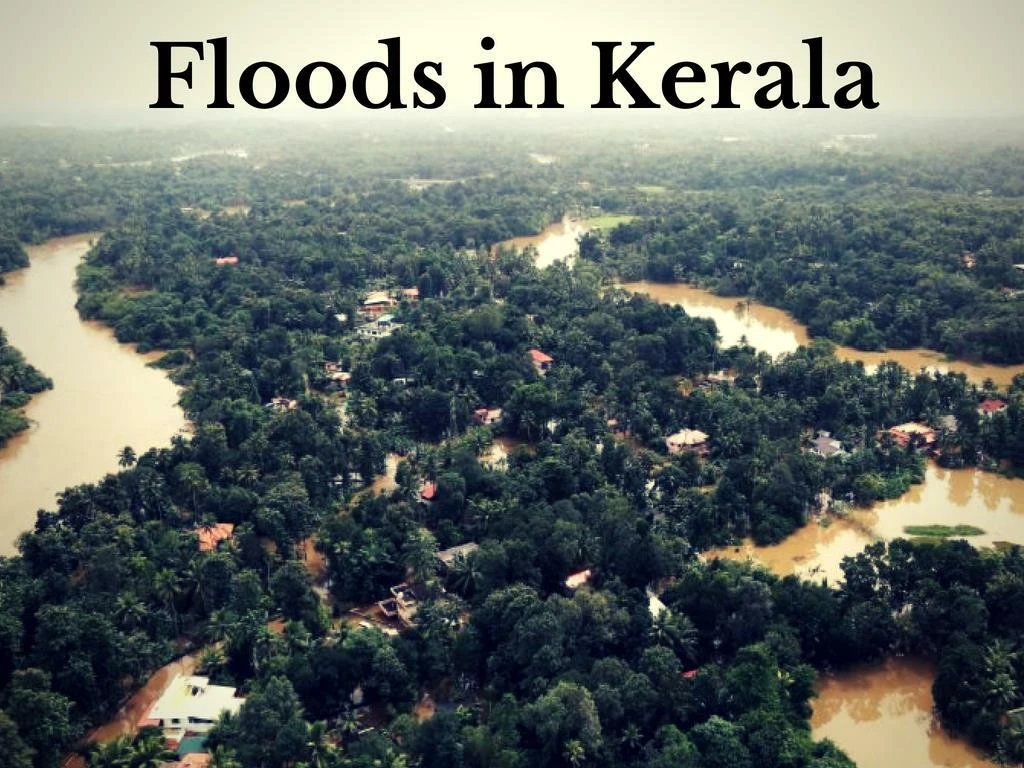
Floods in Kerala 2018
Aug 18, 2018
2.33k likes | 14.37k Views
Kerala is experiencing its worst floods in a century.
Share Presentation
- rescue workers
- india august 15
- flooded cochin international airport

Presentation Transcript
Floods in Kerala
People are airlifted by the Indian Navy soldiers during a rescue operation at a flooded area in the southern state of Kerala, India, August 17, 2018. REUTERS/Sivaram V
An aerial view shows partially submerged houses at a flooded area in the southern state of Kerala, India, August 17, 2018. REUTERS/Sivaram V
A sick man waits to be airlifted by the Indian Navy soldiers from a flooded area in the southern state of Kerala, India, August 17, 2018. REUTERS/Sivaram V
Rescue workers help people to cross a flooded road after the opening of Idamalayr, Cheruthoni and Mullaperiyar dam shutters following heavy rains, on the outskirts of Kochi, India, August 16, 2018. REUTERS/Sivaram V
Rescue workers evacuate people from flooded areas after the opening of Idamalayr, Cheruthoni and Mullaperiyar dam shutters following heavy rains, on the outskirts of Kochi, India, August 16, 2018. REUTERS/Sivaram V
Partially submerged trucks are seen surrounded by floodwaters at a parking bay after the opening of Idamalayr, Cheruthoni and Mullaperiyar dam shutters following heavy rains, on the outskirts of Kochi, August 16, 2018. REUTERS/Sivaram V
A man rescues a drowning man from a flooded area after the opening of Idamalayr, Cheruthoni and Mullaperiyar dam shutters following heavy rains, on the outskirts of Kochi, India August 16, 2018. REUTERS/Sivaram V
A man walks inside the flooded Cochin international airport after the opening of Idamalayar, Cheruthoni and Mullaperiyar dam shutters following heavy rain, on the outskirts of Kochi, India, August 15, 2018. REUTERS/Sivaram V
Indian Army soldiers rescue people from flood affected areas after the opening of Idamalayar, Cheruthoni and Mullaperiyar dam shutters following heavy rains, on the outskirts of Kochi, India August 15, 2018. REUTERS/Sivaram V
Residents affected by flooding move to safer places after the opening of Idamalayar, Cheruthoni and Mullaperiyar dam shutters following heavy rains, on the outskirts of Kochi, India August 15, 2018. REUTERS/Sivaram V
Rescue workers evacuate people from flooded areas after the opening of Idamalayar, Cheruthoni and Mullaperiyar dam shutters following heavy rains, on the outskirts of Kochi, India August 15, 2018. REUTERS/Sivaram V
Rescue personnel patrol the flooded waters on the banks of Periyar River after the opening of Idamalayar and Cheruthoni dam shutters following heavy rains, on the outskirts of Kochi, August 10,2018. REUTERS/Sivaram V
People stand on the steps of Aluva Shiva Temple complex submerged in water after the opening of Idamalayar dam shutter following heavy rains, on the outskirts of Kochi, India, August 9, 2018. REUTERS/Sivaram V
People help a woman disembark from an Indian Navy helicopter at a relief camp after being rescued from a flooded area in the southern state of Kerala, India, August 17, 2018. REUTERS/Sivaram V
People wait for aid on the roof of their house at a flooded area in Kerala, India, August 17, 2018. REUTERS/Sivaram V
- More by User
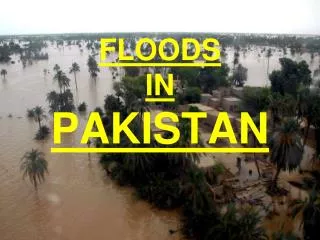
FLOODS IN PAKISTAN
FLOODS IN PAKISTAN. SCALE CURRENT SITUATION RELIEF OPERATIONS REQUIREMENTS SLIDE SHOW. SEQUENCE OF THE PRESENTATION. GENERAL. Unprecedented floods, affecting the entire length of Pakistan with maximum damage in provinces of KPK, Punjab and Sind
4.51k views • 54 slides

1.25k views • 54 slides
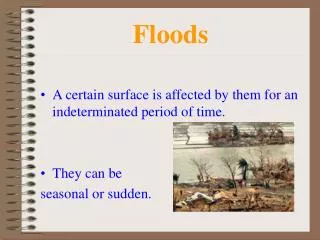
Floods. A certain surface is affected by them for an indeterminated period of time. They can be seasonal or sudden. Natural Causes. Excesive rains. Overflowing of rivers, lagoons, lakes,etc. Human causes. Bad agricultural practice Bad infraestructure Deforestation Urban increase.
624 views • 5 slides

733 views • 42 slides

FLOODS, FLASH FLOODS
Flash Flood Safety Rules. Avoid walking, swimming, or driving in flood waters.Stay away from high water, storm drains, ditches, ravines, or culverts. If it is moving swiftly, even water six inches deep can knock you off your feet.If you come upon flood waters, stop, turn around, and go another w
405 views • 5 slides

FLOODS. PG. 50 FLOODS CHAPTER 12 Part of the Hydrologic Cycle - the circulation of Earth's water supply Streams are defined as running water confined to a channel that moves due to gravity Streams are erosional (take stuff away) and depositional (leave stuff behind) agents
636 views • 35 slides
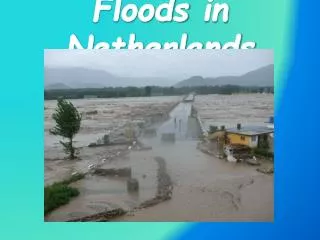
Floods in Netherlands
Floods in Netherlands. During the floods in January / February 1995 three rivers courses of Maas,Waal and Nederrijn in the central delta area of the Netherlands were affected.
326 views • 5 slides

Chapter 3: Section 3. FLOODS. Causes. Floods occur when so much water pours into a stream or river that it overflows its banks and covers the land on either side of the channel Flash flood - a sudden, violent flood that occurs within a few hours, or even minutes of a storm. Flood safety.
455 views • 11 slides

FLOODS. By Rome Birchfield Science Mr. Shepard. N.C Clyde Flood. The North C arolina Clyde 2004 flood did a lot of damage to the town and killed two people a old woman and a firefighter. What are Floods C aused by.
355 views • 8 slides

Floods. CERT Basic Training Hazards. When Floods Occur. Any time a body of water rises to cover what is usually dry land One of most common hazards 75% of Federally declared disasters May be local or widespread May develop slowly or fast. Causes of Floods and Flood Damage. Heavy rain
449 views • 10 slides

Floods. Javen And Alex And Andrew.
211 views • 7 slides

Floods. By Alexa Jain Quinn Petty Emma Kay White Owen Wilder Nicholas Cheves. What is a flood?. A flood is a lot of water that can drown people. Floods can damage thousands of people’s houses. Floods rarely happen. Where do floods occur?.
430 views • 6 slides

Floods. Chapter 17 Sections 2 & 3 Pages 567-582. Floods. Are the most dangerous weather-related events in the US. Floods occur when water pours into a stream or river that it overflows its banks and covers the land on either side. Flash Floods.
709 views • 7 slides

Floods. By: Ann McQueen & Parker. The Causes. Heavy rain When rivers overflow When ocean waves come ashore When snow melts too quickly When dams break. Preparing for a Flood. Always plan ahead make a kit. Know where you and your pets can go to be safe.
228 views • 7 slides

Floods. By;Shyanne Rogers Mr.Shepard. Interesting pictuure 3. http://www.riverdalecity.com/meetings_events/flood_99/SlideShow/Flood.htm. A flood is causes of many events such as intense rainfalls. What causes a flood?. http://www.wrh.noaa.gov/tfx/hydro/FAW/fawmain.php?wfo=tfx.
366 views • 11 slides

Floods. By B randon. Floods disasters. Flood will destroy your houses. A flood is when a lot of water comes at one time. Floods mlii. S tips. Have a disaster plan and prepare a disaster supplies kit for your home and car. references. http://www.weatherwiskids.com/.
377 views • 4 slides

Floods. Definition: Natural process of overbank flow Amount & distribution of precipitation in the drainage basin Rate at which the precipitation soaks into the soil Vegetated vs barren vs rocky Rate at which surface runoff reaches the stream Differs for agricultural vs forested vs urban
558 views • 14 slides
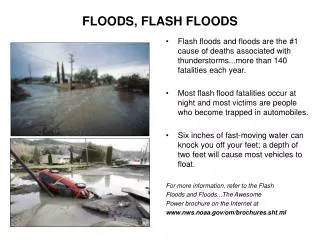
FLOODS, FLASH FLOODS. Flash floods and floods are the #1 cause of deaths associated with thunderstorms...more than 140 fatalities each year. Most flash flood fatalities occur at night and most victims are people who become trapped in automobiles.
2.92k views • 5 slides

Floods. Modified by the Office of Preparedness. Floods. Defined: any time a body of water rises to cover what is usually dry land Are one of most common hazards 75% of Federally declared disasters May be local or widespread May develop slowly or quickly.
458 views • 10 slides

Floods. By : Codie Mullins. Facts About Floods. Six inches of fast flowing water will knock you off your feet. Four inches of water will ruin your carpet. Two feet of water will float your car. This is what can happen when a alert is issued. Floods.
516 views • 8 slides

Kerala TET Application form 2018
Kerala TET Application form 2018 has released official notification a official site.
48 views • 3 slides
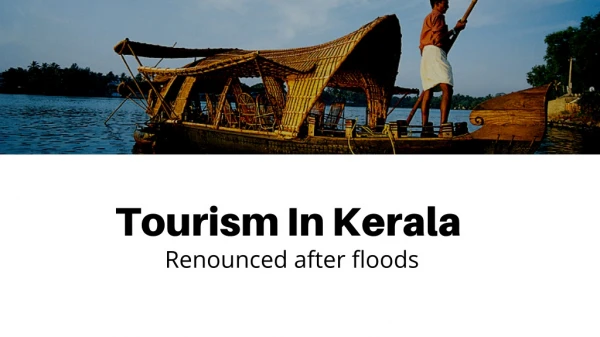
Tourism in Kerala renounced after floods
How Kerala has returned back with tourists
129 views • 7 slides

IMAGES
VIDEO
COMMENTS
Effects. In some areas, floodwater was between 3-4.5m deep. Floods in the southern Indian state of Kerala have killed more than 410 people since June 2018 in what local officials said was the worst flooding in 100 years. Many of those who died had been crushed under debris caused by landslides.
Kerala flood August 2018. Aug 26, 2018 • Download as PPTX, PDF •. 73 likes • 30,063 views. Ritesh Singh. Brief Description of Kerala Flood of 2018 and In starting some flood infomation is also discussed and also given information about donation by diffferent peoples and commpanys and states. Read more. Environment. 1 of 24.
Kerala Floods. IT IS A PPT ON THE DESTRUCTION DONE BY FLOOD IN KERALA.. 1. 2. IT IS A NATURAL EVENT OR OCCURRENCE WHERE A PIECE OF LAND (OR AREA)THAT IS USUALLY DRY LAND, SUDDENLY GETS SUBMERGED UNDERWATER. 3. TO IDENTIFYTHE CAUSES OF FLOODS TO DESCRIBETHE OVERALL IMPACT OF FLOODING TO FORMULATEA STRATEGY FOR FLOOD AND KNOWTHE PROBLEMS OF ...
Presentation on Flood Management | PPT | Case Study:Kerala Flood | Disaster Management | What to do?🤔_____Follow me o...
Kerala Floods August 2018 Page 1 Kerala Flood of August 2018 1.0 Introduction Kerala State has an average annual precipitation of about 3000 mm. The rainfall in the State is controlled by the South-west and North-east monsoons. About 90% of the rainfall occurs during six monsoon months. The high intensity storms prevailing during the monsoon months
Kerala experienced an abnormally high rainfall from 1 June 2018 to 19 August 2018. This resulted in severe flooding in 13 out of 14 districts in the State. As per IMD data, Kerala received 2346.6 ...
Kerala has a total geographical area of 38863 km2, with a North-South orientation and elongated Shape. It has approximate length of 561 km and very short width of approximately 100 km, which gives a short time of travel for water to reach downstream areas from its farthest point at ridgeline. The major soil type of Kerala are Clay/Clay skeletal ...
KERALA FLOOD CASE STUDY - Free download as Powerpoint Presentation (.ppt / .pptx), PDF File (.pdf), Text File (.txt) or view presentation slides online. cs
Generally, the Monsoon in India arrives when it hits Kerala and moves on further to other states giving relief from the scorching heat. However, the southwest monsoon of 2018 brought disaster in the form of severe floods and rains which resulted in over 433 deaths and affected all the districts of the state (Government of Kerala, 2018).According to the state government, the floods have ...
Specifically in this project, we study the "KeralaGram" group on Telegram, which had 15,000 users at the time of the 2018 flood and was focused on issues/events/news related to the state of Kerala. While Twitter has been extensively used for social sensing, the use of Telegram is less common. Most relevant Telegram research involves either ...
Abstract. Extreme precipitation events and flooding that cause losses to human lives and infrastructure have increased under the warming climate. In August 2018, the state of Kerala (India) witnessed large-scale flooding, which affected millions of people and caused 400 or more deaths. Here, we examine the return period of extreme rainfall and the potential role of reservoirs in the recent ...
1, Figure 2 and Figure 3 shows the departure of monthly rainfall in Kerala as compared to the long period average. 1.3. Monsoon rainfall assessment - 8th to 17th August 2018 The peak spell of rains that created the extreme floods in Kerala occurred between 8th to 17th of August 2018. The comparison of rainfall prediction and qualitative ...
The current study has analyzed the spatial and temporal variation in the extent of severe flooding in Kerala during the monsoon months of 2018. The south-central parts of Kerala are most severely ...
483 dead,15 went missing [1] Property damage. ₹ 40,000 crore (US$5.0 billion) (estimated) [2] On 16 August 2018, severe floods affected the south Indian state Kerala, due to unusually high rainfall during the monsoon season. [3] [4] [5] It was the worst flood in Kerala in nearly a century. [6] Over 483 people died, and 15 went missing. [7]
A Case Study on Kerala Floods P. Srija *, G. Nithin , V. Chaithanya*, M. Sushma Swaraj* and Dr. M. Sridevi** ... 2003: Flood occurred on 24th June. Kerala received 1722.6 mm rainfall. Caused due to heavy rains and Landslides. This flood affected 11 out of 14 districts (116 villages) and flood damaged 488 houses and 8 ...
Presentation Transcript. Floods in Kerala. People are airlifted by the Indian Navy soldiers during a rescue operation at a flooded area in the southern state of Kerala, India, August 17, 2018. REUTERS/Sivaram V. An aerial view shows partially submerged houses at a flooded area in the southern state of Kerala, India, August 17, 2018.
Oct 19, 2021. Manimalayar witnesses biggest flood in 64 years. Being a coastal state of India and much of the land being part of the fragile Western Ghats, Kerala is very sensitive to climate ...
During the heavy rainfall over the monsoon period from 1 June to 18 August 2020, all 14 districts in Kerala were affected with 104 dead and 40 injured. Four districts in Kerala were flooded on 7 August 2020 (Idukki, Wayanad, Malappuram and Kottayam). Major reported incidents in relation to flooding include a landslide in Idukki district on 6 August, claiming 66 lives and an Air India plane ...
Flood ppt - Download as a PDF or view online for free. Flood ppt - Download as a PDF or view online for free ... The case study on the 2018 Kerala floods in India described the heavy rainfall that caused widespread flooding and landslides. Over 400 people died and over 1 million people were displaced from their homes. Infrastructure and ...
kerala flood KULDEEP.pptx - Free download as Powerpoint Presentation (.ppt / .pptx), PDF File (.pdf), Text File (.txt) or view presentation slides online.
KERALA FLOODS OF 2018: AN OVERVIEW. Kerala, a southwestern coastal state of India, one of the most developed and beautiful states of India, had an unparalleled topography of backwaters, hill stations, beaches, splendidly diverse flora and fauna in its forests, widespread paddy fields, dense groves of coconut trees, and an extremely noble ...
Beginning on August 15th 2018, severe floods were affected in Kerala due to unusually high rain fall during the monsoon season. It was the worst flooding in Kerala nearly a century. Almost 370 people died and 33000 peoples are rescued. According to Kerala Govt. one sixth of the total population of Kerala had been directly affected by flood.
Case Study of Flood 2018 Kerala State Qazi Faizan Ali B.Tech Final Year Student Civil Engineering Department (Dr. Virendra Swarup Memorial Trust Group of Institutions, Unnao, India) Abstract: This document is the case study of flood occurred in Kerala 2018.It will gives the entire description that on what bases this flood came into existence.